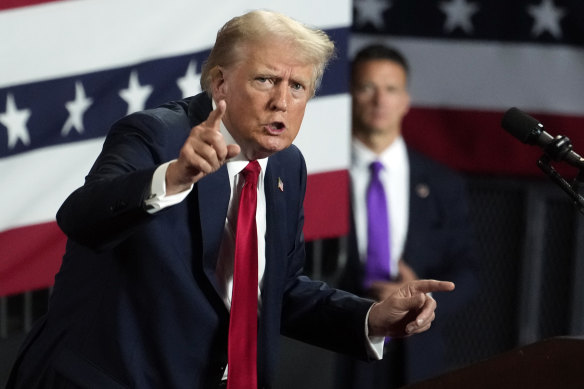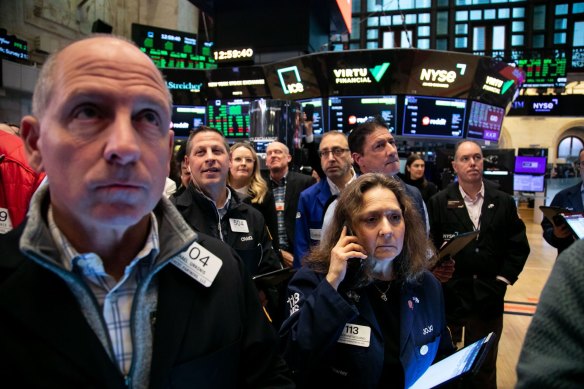
The markets are now pricing in rate cuts in September, November and December amid signs that the US unemployment is rising (it was 4.1 per cent in June, the highest since 2021 and well above the 3.7 per cent rate at the start of the year), employment opportunities are shrinking, wages growth is slowing and economic growth, while still quite strong, is also showing signs of weakening.
After a rocky first quarter, the core inflation rate that the Fed focuses on was clearly trending down towards its 2 per cent target in the June quarter. That, and the rising unemployment rate, have caused some former Fed board members to argue that rates need to be cut sooner rather than later if a recession is to be avoided.

Donald Trump told Bloomberg recently that a rate cut before the election by the Fed would be “something that they know they shouldn’t be doing.”Credit: AP
The Fed, however, remains data-dependent and cautious – it remains “attentive to the risks on both sides of its dual mandate” (inflation and employment) – and while its formal statement said the risks to achieving its goals were continuing to move into a better balance, it didn’t expect it would be appropriate to reduce the target range for its policy rate until it had greater confidence that inflation was moving sustainably towards two per cent.
There’s enough of a gap between now at the Fed’s September meeting for the data to help provide that confidence, assuming the current trends in the US economy are sustained.
The September rate cut telegraphed by Powell carries political sensitivity, as would a November move, given that the Fed’s November meeting is scheduled for the 6th and 7th of that month, immediately after the November 5 US election.
Donald Trump and the Republicans would inevitably characterise any rate reduction before the election as a political intervention designed to help the Democrats, with Trump telling Bloomberg recently that a rate cut before the election would be “something that they know they shouldn’t be doing.”
The softening of the Fed’s conservative line on inflation and interest rates is positive for, not just US financial markets, but central banks and markets elsewhere.
Trump has said he would let Powell serve out the remainder of his term as the Fed’s chair, which expires in 2026, “especially if I thought he was doing the right thing.” In his term as president, Trump railed against the Fed’s decisions and threatened to fire Powell before discovering that he didn’t have the authority.
His advisers have been investigating mechanisms for exerting influence and even control of the Fed, an independent agency, if the Republicans do win control of the White House and Congress in the election.
Trump’s agenda of more tariffs, more tax cuts and mass deportations of immigrants would be highly inflationary and bring a new Trump administration into direct conflict with the Fed, which would normally be expected to raise rates sharply again to counter those effects.
Democrats, of course, would argue that failing to cut rates despite evidence that they should be reduced would be political interference.
The Biden administration has been studiously neutral in any commentary on the Fed’s decision-making, and a Kamala Harris administration would be expected to remain at arm’s length from monetary policies.

The markets are now pricing in rate cuts in September, November and December.Credit: Bloomberg
The Fed’s softening of its conservative line on inflation and interest rates is positive for not just US financial markets but also central banks and markets elsewhere. A US rate cut would provide cover for other central banks to lower their own policy rates without the fear of sparking destabilising capital flows.
The degree of influence the US and its bond and currency markets have on the rest of the world is such that it constrains monetary policies elsewhere because too significant a gap between their interest rates and America risks an exodus of capital, significant currency depreciations and more inflation.
Only this week, the Bank of Japan announced an increase in its interest rates, only the second since 2007, to try to support a currency that recently struck 38-year lows against the dollar because of the wide spread between US and Japanese interest rates, as well as to rein in an inflation rate that, fuelled by the weak yen, has been threatening to get out of control.
As the US markets’ response indicates, share and bond market investors are excited about the prospect that rates are about to start trending lower.
To date, they have been consistently disappointed – they started the year pricing in as many as six rate cuts this year – but the prospect of at least one and potentially as many as three rate reductions before the end of the year is very positive for shares, particularly high-earnings-multiple tech shares, and bond yields.
Until the September meeting, we won’t get a proper insight into how the members of the Open Market Committee are thinking about the prospect of more than one rate cut this year. At their last meeting in June, the median projection of committee members was for a single reduction this year, but several next year.
Loading
The annual Jackson Hole conference, which brings together central bankers, economists, academics and others interested in economic policy, will be held at the end of this month.
It is possible that Powell will flesh out the Fed’s expectations at that meeting, which has often been used to provide clearer signals of US monetary policy, but in any event, his comments after this week’s meeting provide the clearest signal yet that the Fed is rapidly approaching the moment it declares victory in its 28-month campaign against inflation.
The Business Briefing newsletter delivers major stories, exclusive coverage and expert opinion. Sign up to get it every weekday morning.









 Add Category
Add Category